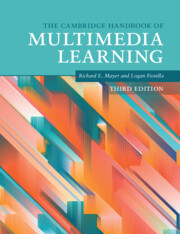Book contents
- The Cambridge Handbook of Multimedia Learning
- The Cambridge Handbook of Multimedia Learning
- Copyright page
- Contents
- Figures
- Tables
- Contributors
- Preface
- Acknowledgments
- Part I Background
- Part II Theoretical Foundations
- 5 Cognitive Theory of Multimedia Learning
- 6 Implications of Cognitive Load Theory for Multimedia Learning
- 7 Integrated Model of Text and Picture Comprehension
- 8 Implications of the Four Component Instructional Design Model for Multimedia Learning
- 9 Motivation and Affect in Multimedia Learning
- 10 Metacognition in Multimedia Learning
- Part III Basic Principles of Multimedia Learning
- Part IV Principles for Reducing Extraneous Processing in Multimedia Learning
- Part V Principles for Managing Essential Processing in Multimedia Learning
- Part VI Principles Based on Social and Affective Features of Multimedia Learning
- Part VII Principles Based on Generative Activity in Multimedia Learning
- Part VIII Multimedia Learning with Media
- Author Index
- Subject Index
- References
7 - Integrated Model of Text and Picture Comprehension
from Part II - Theoretical Foundations
Published online by Cambridge University Press: 19 November 2021
- The Cambridge Handbook of Multimedia Learning
- The Cambridge Handbook of Multimedia Learning
- Copyright page
- Contents
- Figures
- Tables
- Contributors
- Preface
- Acknowledgments
- Part I Background
- Part II Theoretical Foundations
- 5 Cognitive Theory of Multimedia Learning
- 6 Implications of Cognitive Load Theory for Multimedia Learning
- 7 Integrated Model of Text and Picture Comprehension
- 8 Implications of the Four Component Instructional Design Model for Multimedia Learning
- 9 Motivation and Affect in Multimedia Learning
- 10 Metacognition in Multimedia Learning
- Part III Basic Principles of Multimedia Learning
- Part IV Principles for Reducing Extraneous Processing in Multimedia Learning
- Part V Principles for Managing Essential Processing in Multimedia Learning
- Part VI Principles Based on Social and Affective Features of Multimedia Learning
- Part VII Principles Based on Generative Activity in Multimedia Learning
- Part VIII Multimedia Learning with Media
- Author Index
- Subject Index
- References
Summary
An integrated model of text and picture comprehension is presented in this chapter which takes into account that learners can use multiple sensory modalities combined with different forms of representation. The model encompasses listening comprehension, reading comprehension, visual picture comprehension, and auditory picture comprehension (i.e., sound comprehension). The model’s cognitive architecture consists of modality-specific sensory registers, working memory, and long-term memory. Within this architecture, a distinction is made between perception-bound processing of text surface or picture surface structures, on the one hand, and cognitive processing of semantic deep structures, on the other hand.
Keywords
Information
- Type
- Chapter
- Information
- The Cambridge Handbook of Multimedia Learning , pp. 82 - 99Publisher: Cambridge University PressPrint publication year: 2021
References
Accessibility standard: Unknown
Why this information is here
This section outlines the accessibility features of this content - including support for screen readers, full keyboard navigation and high-contrast display options. This may not be relevant for you.Accessibility Information
- 9
- Cited by
